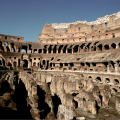COLOSSEO (COLISEUM)
The Flavian amphitheatre was completed in 80's. It hosted the Rome Games, with gladiatorial battles in particular.
The Colosseum is the symbol of Rome and the largest amphitheatre of antiquity. It was once the site of the greatest gladiatorial battles of Roman times, and was later used as a dwelling, before being stripped of its materials, transformed into a place of Christian worship and then abandoned until its rehabilitation.
The golden age of the Colosseum. The Flavian amphitheatre, named after the dynasty of emperors who built it, was the most ambitious project of our era. Emperor Vespasian (69 - 79 AD) decided to build it in 72 AD, and it was completed in 80 AD, during the reign of his son Emperor Titus (39 - 81 AD). His aim was to provide the city with an amphitheatre worthy of the reputation of the Games of Rome, which had been held on the Campus Martius in a temporary building since the great fire. Nearly 100 consecutive days were devoted to its inauguration, resulting in the deaths of dozens of gladiators and almost 9,000 animals! It was Domitian (81 - 96 AD) who later completed the underground structures and designed the gladiator barracks(Ludi) on the eastern side of the valley. Damage was caused by a major fire in 217 AD and by earthquakes. It was therefore remodeled several times up to the 6th century. Gladiatorial combat, condemned by the Christian emperors, was suspended by Honorius and abolished by Valentinian in 438 AD. The last venationes took place in 523 AD, marking the beginning of the Colosseum's slow decline.
Abandonment and reuse. First, the ground-floor rooms were converted into living quarters, then in the 12th and 13th centuries, the Colosseum became part of the Frangipane family fortress. In 1345, an earthquake toppled part of the arena, followed by widespread looting of building materials. Blocks of stone were ripped out, columns dismantled, bricks salvaged, and the iron and lead spikes (over 300 tons) that held the travertine blocks or marble panels together were removed, which explains the many holes in the brick and stone walls. Many Roman monuments were built using material from the Colosseum, including St. Peter's Basilica, the Palazzo della Cancelleria and St. Mark's Church, to name but a few. Roman humanists in the 15th century called for its protection, but it wasn't until 1753 that Pope Benedict XIV forbade the Colosseum to be used on the grounds that many Christians had died there as martyrs (which was in fact untrue, as the persecutions took place at the Circus Maximus, the great chariot-racing stadium). In any case, this enabled the amphitheatre to be preserved and the Stations of the Cross to be held every Good Friday in the presence of the Pope. The marble facings and bolster blocks were stolen, as was anything that could be reused to build elsewhere, particularly after the earthquakes that destroyed parts of Rome in the 14th century. In the same century, a religious order was established here. The building had become imposing, too imposing even, and was partly destroyed in a city that was becoming more attractive in the 17th and 18th centuries. Pope Clement XI (1649-1721) transformed it into a place of the martyrdom of the first Christians. A Way of the Cross was built here.
Restoration. During Napoleon's campaign in Italy, the French emperor, a great lover of ancient history, ordered archaeological excavations to be carried out here, as he always did on his travels. It was only in the 19th century that further excavations were undertaken to uncover the underground structures of the arena, as well as major restoration work to bring the "Colossus" back to the state it is in today. The titanic work involved restoring the ambulacres, the underground passages, the north and south facades and bringing the entire building up to standard.
Architectural aspect. The Colosseum is 188 m long and 156 m wide, covering a surface area of 3,357 square metres. The walls are 48 m high. The central arena measures 86 m by 54 m and is surrounded by an enclosure 4.5 m high. Of course, the building was constructed in travertine, the stone of Rome, mixed with bricks. Three levels of 80 arcades form the exterior façade, framed by semi-columns with Tuscan capitals on the second floor, Ionian capitals on the second and Corinthian capitals on the third. The interior surface is known as the cavea, and the subterranean passages now uncovered were once covered with a wooden floor that formed the arena in the center of the rows of bleachers. Outside, a state-of-the-art system of some 80 numbered doors enabled the 73,000 spectators to quickly access their seats, according to their condition, on all four levels. As was customary in ancient times, on Egyptian or Roman buildings, flagpoles increased the height of the edifice. At the top, Domitian had a canvas(velarium) made of strips of cloth pulled by a team of 100 sailors to protect spectators from the sun.
Online booking strongly recommended. In Rome, there are two official ticket offices: Piazza del Colosseo and Largo della Salara Vecchia. Waiting times can be very long, however, and the number of tickets is limited. Tickets are valid only on the day indicated.
Did you know? This review was written by our professional authors.
Members' reviews on COLOSSEO (COLISEUM)
The ratings and reviews below reflect the subjective opinions of members and not the opinion of The Little Witty.












il y a même un ascenseur pour les personnes a mobilité réduite car vous le visité sur plusieurs etages et les marches etant d'époques elle sont tres hautes.
le Colisée ouvre a 08h30, perso on y etait a 08h20 et tres bien on est arrivé avant les groupes et pas grand monde donc facile pour les photos :)